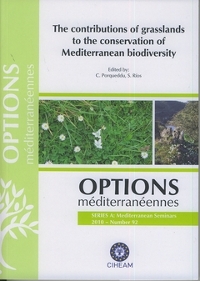| Article précédent | p. 113-116 | Article suivant |
Differences in growth characteristics between ecotypes of Dactylis glomerata L. under waterdeficit conditions
It has been predicted that in the Mediterranean region the climate will become warmer and drier in the following years as a result of global changes. As consequent, the development of improved watersaving varieties is a high priority in forage grass breeding programs. In this experiment the adaptation responses to water-deficit conditions of two ecotypes of Dactylis glomerata L. (cocksfoot) were studied. The experiment was conducted in the farm of Aristotle University of Thessaloniki, northern Greece. Two ecotypes of cocksfoot originating from different mountainous habitats, a fir forest and an adjacent open grassland, were selected in 2008. Plants of these ecotypes were planted into pots and subjected to the following water supplies during the growing season from April to June: (i) well-watered conditions; and (ii) rainfed conditions. The number of tillers and the leaf area were measured weekly and the above biomass production was determined at the end of the experimental period. According to the results, the grassland ecotypes tended to have higher number of tillers than the forest ecotype under well-water conditions but lower under rainfed conditions. Additionally, at the end of the experimental season the forest ecotype had significantly higher specific leaf area and dry matter production in comparison to the grassland ecotype in both well-watered and rainfed conditions.
Il est prévu que dans la région méditerranéenne le climat devienne plus chaud et plus sec dans les années à venir suite aux changements globaux. Il en résulte que le développement de variétés nécessitant moins d'apports en eau est une haute priorité des programmes de recherche sur les céréales. Dans l'étude présentée ici, les réponses adaptatives de deux écotypes de Dactylis glomerata L. à un stress hydrique sont étudiées. L'étude a été réalisée à l'Université Aristote de Thessalonique en Grèce du Nord. Deux écotypes de dactyles agglomérés provenant de différents milieux montagneux, une forêt de sapins et une prairie adjacente, ont été prélevés en 2008. Les plants ont été empotés et alimentés en eau lors de la période de croissance entre avril et juin suivant deux procédures : conditions abondantes ou conditions analogues à celles fournies par les pluies. Le nombre de jeunes pousses est comptabilisé toutes les semaines, la surface foliaire et la production de biomasse déterminées à la fin de l'étude. Les résultats indiquent que l'écotype de prairie présente plus de pousses que celui de forêt lorsque l'apport en eau est abondant, mais moins dans le cas d'un apport analogue aux pluies. De plus, à la fin de l'expérimentation, l'écotype de forêt avait une surface foliaire et une production de matière sèche significativement plus importante que l'écotype de prairie, dans les conditions normales de précipitations.
- [ Afficher ]
- [ Télécharger ]
- [ Exporter la citation ]
Vous pouvez télécharger la citation au format :
- [ Imprimer ]
-
Mots-clés
ADAPTATION, CROISSANCE, DACTYLIS GLOMERATA, ECOTYPE, MESURE, SECHERESSECiter cet article
Abraham E.M., Kyriazopoulos A.P., Parissi Z.M., Karatassiou M., Kostopoulou P., Anjalanidou K., Katsouta C. Differences in growth characteristics between ecotypes of Dactylis glomerata L. under waterdeficit conditions. In : Porqueddu C. (ed.), Ríos S. (ed.). The contributions of grasslands to the conservation of Mediterranean biodiversity. Zaragoza : CIHEAM / CIBIO / FAO / SEEP, 2010. p. 113-116. (Options Méditerranéennes : Série A. Séminaires Méditerranéens; n. 92). 13. Meeting of the Sub-Network on Mediterranean Forage Resources of the FAO-CIHEAM International Network for the Research and Development of Pasture and Forage Crops, 2010/04/07-10, Alicante (Spain). http://om.ciheam.org/om/pdf/a92/00801226.pdf



